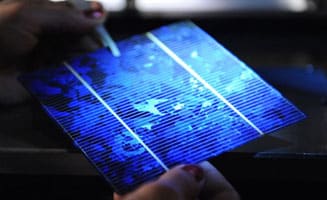
Photovoltaic Efficiency
How Efficient are Photovoltaic Panels
![]() Photovoltaic Efficiency is a major factor in understanding the performance, and cost-effectiveness of your new solar panels. Solar panels, also known as solar modules, are an assembly of individual photovoltaic cells that are electrically interconnected together in series and/or parallel combinations to produce an array with a specific power output.
Photovoltaic Efficiency is a major factor in understanding the performance, and cost-effectiveness of your new solar panels. Solar panels, also known as solar modules, are an assembly of individual photovoltaic cells that are electrically interconnected together in series and/or parallel combinations to produce an array with a specific power output.
The demand for renewable energy sources is soaring as the world increasingly turns to sustainable solutions to combat climate change. Among these solutions, solar energy stands out as a highly viable and accessible option. Central to harnessing this free and easily accessible solar energy are photovoltaic (PV) cells.
We know that in nature, photosynthesis is the process of converting light energy into organic sugars. Well, a photovoltaic cell is basically a single semiconducting solid-state element that converts light energy into electricity with the performance of these photovoltaic (PV) cells described by their current versus voltage (I–V) characteristics.

Photovoltaic cells are made of various semiconductor materials including silicon, cadmium sulphide, cadmium telluride, and gallium arsenide, in single crystalline, polycrystalline, or amorphous forms. The voltage–current output characteristics, and therefore the efficiency of these materials are a function of the characteristics of the light source and their design.
The photovoltaic effect is the phenomenon which occurs when photons light energy penetrate a piece of silicon semiconductor material striking electrons and releasing them from their bound positions around their parent atoms. Combining the property of photon light energy with the characteristics of semiconductor silicon causes electrons in the form of a photocurrent to flow in one direction around an externally connected circuit, creating a potential difference (voltage) allowing electric power to become available.
But What is Photovoltaic Efficiency?
Photovoltaic efficiency refers to the ability of a photovoltaic solar cell to convert sunlight into usable electrical energy. That is, the ratio of the electric power produced by a photovoltaic cell to the amount of direct sunlight falling onto the PV cell over a given area. Thus a higher efficiency means more electricity can be generated from a given amount of sunlight, making the solar panels more effective and cost-efficient.
Photovoltaic efficiency is typically expressed as a percentage, indicating the proportion of sunlight that is converted into electricity. For instance, if a photovoltaic solar panel has an efficiency of 20%, it means that 20% of the sunlight hitting the panel is converted into electrical energy, while the remaining 80% is lost, usually as heat.
The photovoltaic efficiency, η (eta) of a typical solar panel or module is calculated from the maximum electrical power (PMAX), divided by the sum of the panel area, (A) to the total irradiance, (ET). Then we can define mathematically the photovoltaic efficiency of a solar cell, panel or module as being:
Photovoltaic Efficiency Equation

Note that PMAX is the maximum power output rating of the PV cell or panel at “full sun” with an irradiance of 1000 W/m2. The maximum power rating of a photovoltaic panel is commonly calculated as: VMP x IMP. Clearly on dull, overcast or rainy days, both the solar irradiance and the power output from the PV panel will be proportionally reduced. But the panels efficiency will still remain the same.
Consider the Renogy 100 Watt, 12 Volt Monocrystalline Solar Panel label below as our following example.
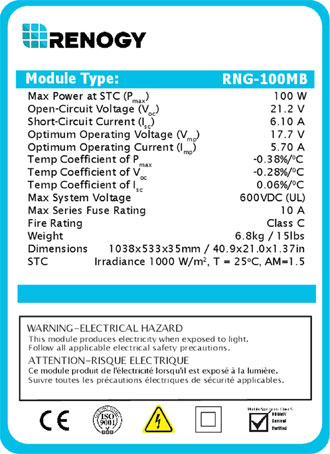
The manufacturer Renogy, states on their solar panel label that at the standard test conditions (STC) used to measure the characteristics of this solar panel. The panel temperature, (T) was 25oC, a solar irradiance used of 1000 W/m2 (one full sun) and an Air Mass of 1.5 (AM = 1.5). Under these conditions this particular Renogy 100 Watt, 12 Volt Monocrystalline Solar Panel will produce a maximum output power (PMAX) of 100 Watts.
The RGN-100 panels label also states that its physical size is 1038 mm by 533 mm. If we assume that its aluminium mounting frame which covers all four sides has a width of, say 25mm (1″) all around to allow for screws and mechanical fixings.
Then the actual size of the semiconductor silicon panel will be approximately: 1038 – (2 x 25) = 988 mm by 533 – (2 x 25) = 483 mm. Thus the actual physical size of the light absorbing silicon is 988 mm by 483 mm = 0.477 m2.
Therefore, we can calculate this 100 watt solar panels photovoltaic efficiency as being:

This basic calculated value of 20.96%, or 21% to the nearest integer, is very close to the manufacture’s quoted value of 22% given on its datasheet. But still goes to show that a 100 watt photovoltaic panel still only has a conversion efficiency of just over 20%. Clearly if this Renogy panel was physically smaller its photovoltaic efficiency would increase for the same 100 watt output. Likewise, if it was physically bigger its conversion efficiency in producing 100 watts would decrease.
Then the m2 size of the panels you install on your roof is determined by their wattage output, since their electrical conversion efficiency is somewhat fixed at between 15% to 20%. But what influencies the efficiency of a solar panel.
Factors Influencing the Efficiency of a Solar Panel
Photovoltaic efficiency is affected by many things. Some of these things are avoidable but others are intrinsic to the installation itself such as the surrounding area as well as the age and design of the system. But the main factors which impact the efficiency of a photovoltaic solar panel include:
- Material Composition – The type of semiconductor material used in the construction of photovoltaic cells plays a significant role in their efficiency. While silicon-based PV cells are still the most common, advancements in new materials are showing promise for higher photovoltaic efficiencies.
- Ambient Temperature – Solar panels generally perform better at lower temperatures since they prefer colder clear skies. Higher temperatures can reduce the overall efficiency of the photovoltaic cells with the peak watt rating on the panels nameplate determined at 25oC.
- Light Intensity and Spectrum – The intensity and spectrum of the sunlight also affects efficiency. Panels are designed to work optimally under specific light conditions at a particular wavelength, and deviations can lead to lower efficiency. Maximum solar irradiance across a unit area of PV surface is defined as 1000 W/m2 at an Air Mass of 1.5.
- Panel Orientation and Angle – The angle of incident at which the sunlight strikes the panel influences efficiency. Optimal orientation and tilt can maximize exposure to sunlight and thereby improve efficiency when the sun is directly overhead. Light absorption also plays a key role in the conversion efficiency which is dependent on the thickness of the PV cell base material.
- Quality of Components – The quality and condition of the components, including the photovoltaic cells, inverter, and other hardware, affect overall efficiency. High-quality components tend to be more efficient and durable.
- Age of the Panel – PV panels are expected to operate for 20 to 30 years, but over time the conversion efficiency of a PV panel can degrade by as much as 0.5% per year due to the daily exposure to the elements and normal wear and tear as it heats up and cools down daily.
In general, the relative effectiveness of a photovoltaic solar panel especially in terms of its peak wattage generation can depend on many factors, especially what the panel is connected to. The actual performance compared to the manufacturers rated performance can be very different, since manufacturers want to sell PV panels and systems according to the price per watt of power produced and not its photovoltaic efficiency.
Average Efficiency of Solar Panels
The average efficiency of a solar panel has seen significant improvement over the years, thanks to technological advancements and better manufacturing processes with the best laboratory efficiencies now reaching 25 to 30% for crystalline multijunction silicon with power ratings increasing from 250 to over 400 Watts.
However, as of now, the average photovoltaic efficiency of commercial solar panels ranges between 15% and 20%. This means that for every 100 watts of solar energy hitting the panel, only 15 to 20 watts are converted into electrical power, watts.
Higher efficiency panels are typically used in residential and commercial building-integrated installations where space is limited, or low light levels for consumer electronics. While lower efficiency panels may be used in large-scale solar farms, or water pumping applications where space is less of a constraint.
Most Efficient Photovoltaic Panels
As we have seen, efficiency is an important factor in the photovoltaic (PV) conversion of solar energy to electrical energy because the sun’s energy is a great source of power. Several companies and research institutions are at the forefront of developing highly efficient photovoltaic panels. Here are some of the most efficient solar PV panels:
- SunPower (Maxeon 6): SunPower’s Maxeon 6 series panels are among the most efficient on the market, with efficiency ratings up to 22.8%. These panels use high-purity silicon and a unique design that minimizes energy loss, making them a top choice for residential and commercial applications.
- LG (NeON R): LG’s NeON R panels offer efficiency ratings of up to 22%. They feature an innovative cell structure without electrodes on the front, which increases the exposure to sunlight and enhances overall efficiency.
- Panasonic (HIT N330): Panasonic’s HIT (Heterojunction with Intrinsic Thin layer) technology panels achieve efficiencies around 21.7%. These panels combine monocrystalline and amorphous silicon layers, reducing electron loss and improving performance.
- REC (Alpha Series): REC’s Alpha Series panels boast efficiencies up to 21.7%. They utilize heterojunction cell technology, which combines the best features of crystalline and thin-film technologies to maximize efficiency and durability.
- First Solar (Series 6): While not as efficient as the top silicon-based panels, First Solar’s cadmium telluride (CdTe) thin-film panels offer efficiencies around 18%. These panels are particularly effective in hot climates and low-light conditions, making them a viable option for utility-scale installations.
Photovoltaic Efficiency Conclusion
Photovoltaic efficiency is a key determinant in the performance and cost-effectiveness of solar panels. The future of photovoltaic efficiency looks promising, with ongoing research and development of second and third-generation photovoltaic cells employing exotic materials aimed at pushing the boundaries of what is now possible.
As photovoltaics turn photons into electrons with average efficiencies ranging between 15% and 20%, and the best solar cell efficiency exceeding 22%, the solar industry continues to make significant strides. Along with advanced computer and A.I. design concepts some photovoltaic solar panels are providing moderate to high conversion efficiencies with power ratings over 400 watts per module, but with minimum material and fabrication costs.
As technology advances, we can expect even more efficient photovoltaic solutions, making solar power an increasingly viable and widespread energy source. Embracing these innovations will be crucial in our global efforts to transition to renewable energy and combat climate change.
To learn more about photovoltaic efficiency, and the most efficient solar PV panels. Then check out Michael Boxwell’s book Solar Electricity Handbook, 2023 Edition from Amazon explaining about the science of photovoltaics, their advantages and the drawbacks you need to consider. As well as explaining the underlying principles of PV system sizing, efficiency and design in a way that most people can understand.


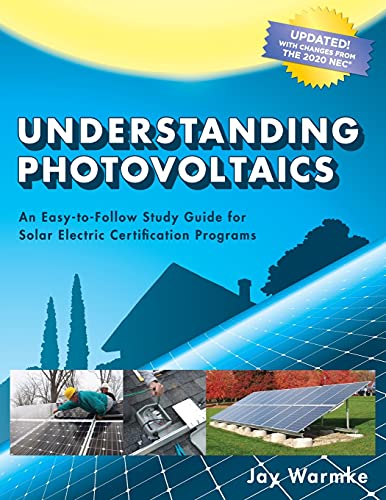
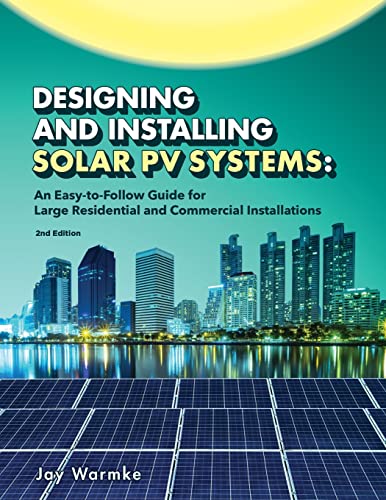
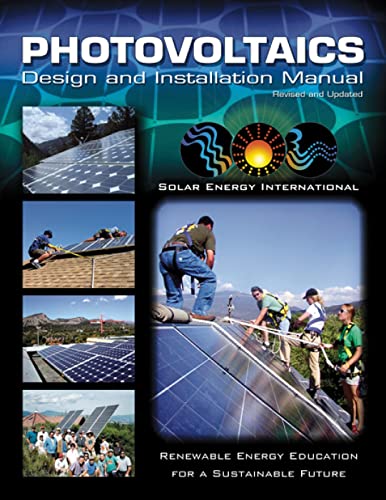

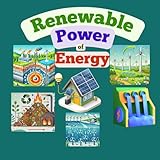



Solar panels in Portugal are a smart choice for sustainable energy. With abundant sunlight and supportive government incentives, installing solar panels can significantly reduce energy bills and carbon footprint. Portugal’s commitment to green energy makes it an ideal place to invest in solar technology and embrace eco-friendly living.